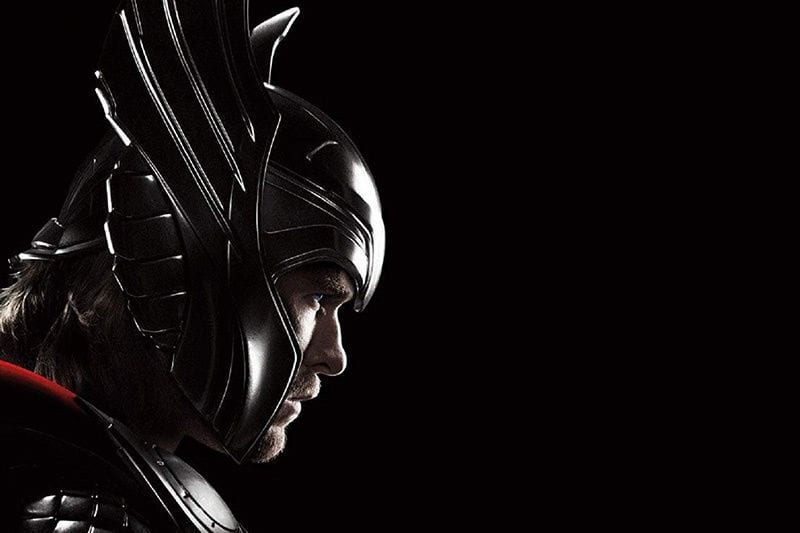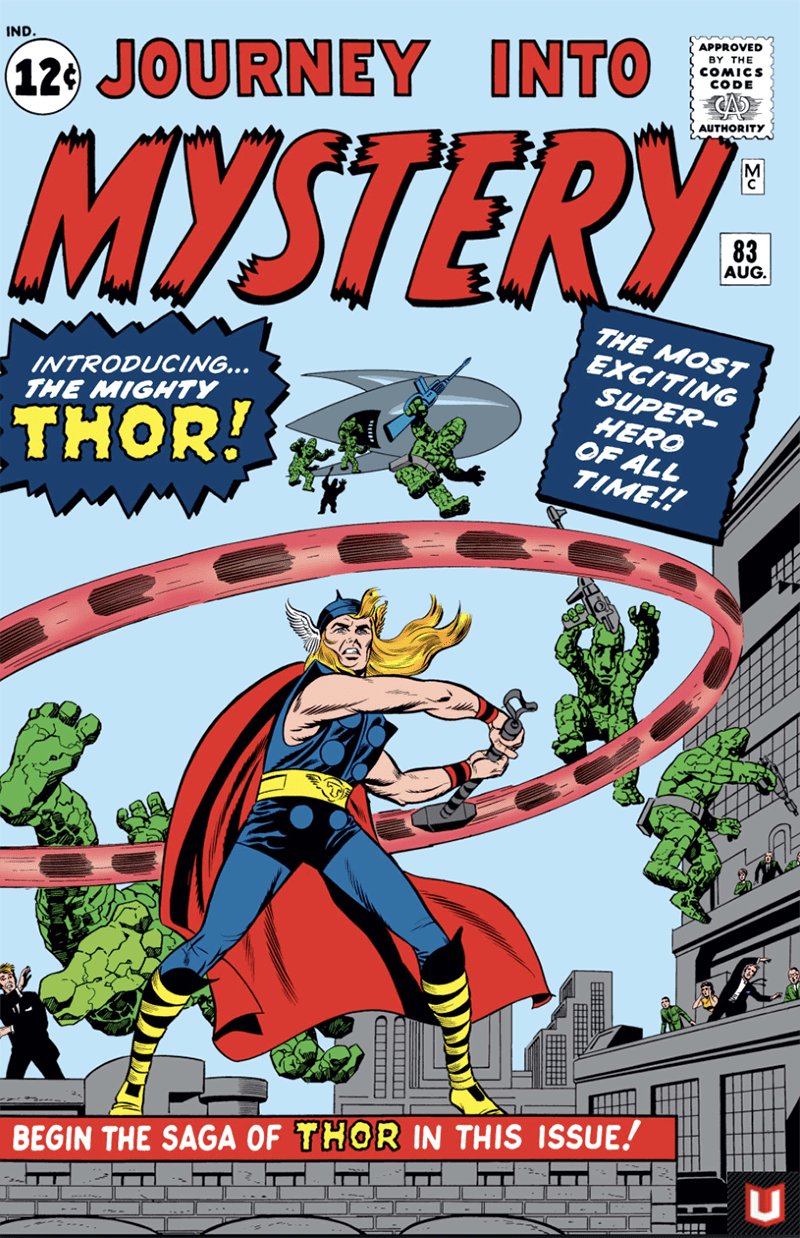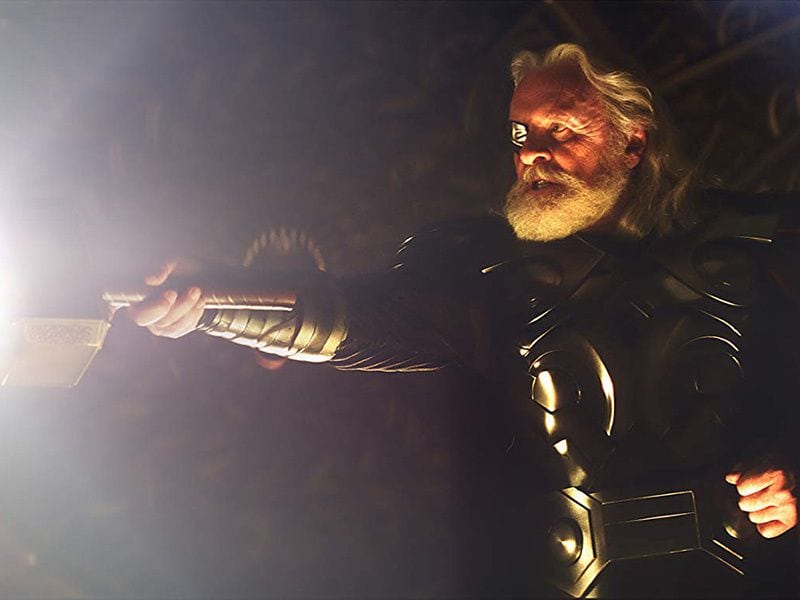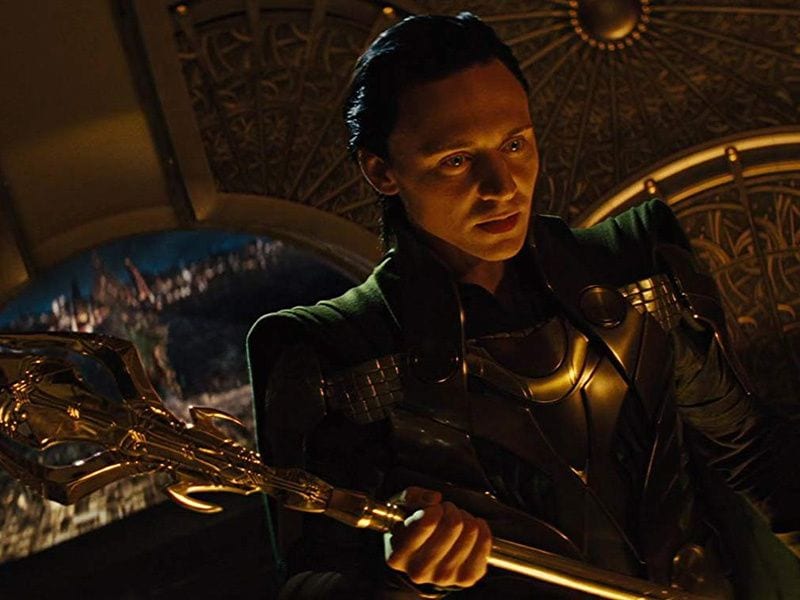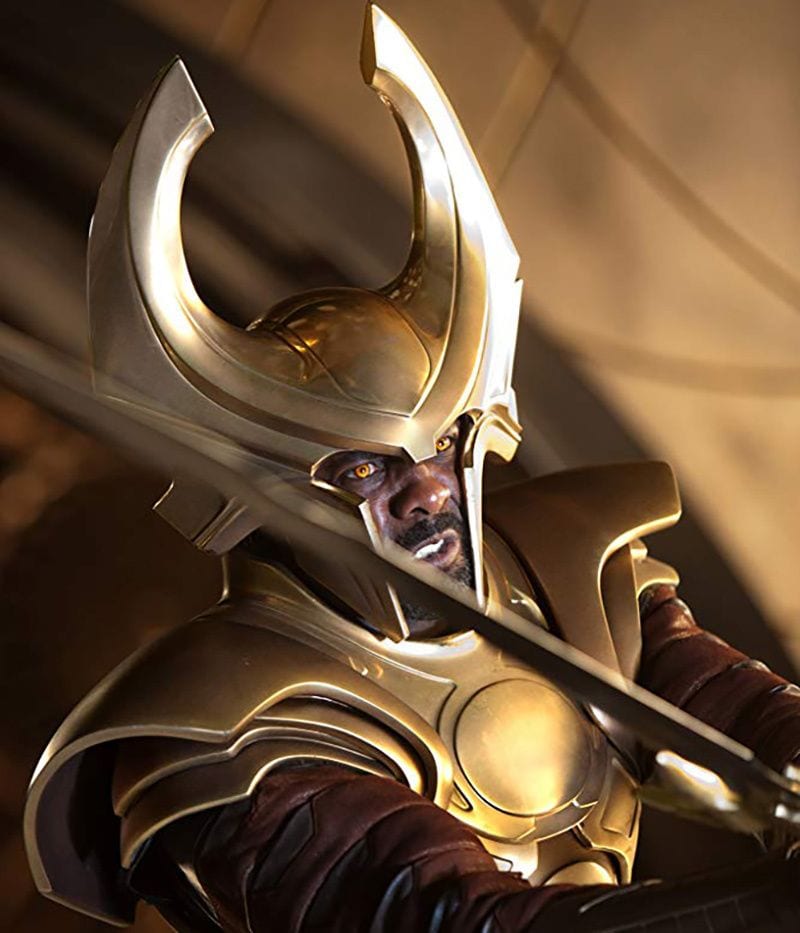Comic book superhero films prior to Thor (Kenneth Branagh, 2011) were resolutely Earth-based, very grounded. Of course they had unbelievable elements, but these elements typically stemmed from reality-based science-fiction. Superheroes in films of the time did not fly around the cosmos like the did in Star Wars or Star Trek. Their adventures were fueled by technology (Batman, Iron Man) or biology (X-Men, Spider-Man) rather than magic or the supernatural. Even an alien character like Superman felt very grounded in his films.
But in comic books, fantasy and cosmic heroes directly interacted with Earth-based, science-based heroes. For Marvel Studios, which was developing an ambitious shared cinematic universe, it was essential to create a fictional world in which fantasy-based cosmic characters could exist alongside Iron Man. If Thor didn’t fit as a character in the MCU, then neither would the Guardians of the Galaxy, Doctor Strange, Thanos, Captain Marvel, etc. This was the challenge in bringing Thor to the big screen. After kicking off the Marvel Cinematic Universe (MCU) with Iron Man (Favreau, 2008), before bringing the universe together in The Avengers (Whedon, 2012), Thor was Marvel Studios’ biggest hurdle. It’s clear when watching the film how nervous the filmmakers were to fully embrace the cosmic fantasy, and all the areas they attempted to mitigate the fantastical elements to be more acceptable to audiences. What’s important, however, is that they succeeded. Thor officially entered the MCU in 2011 and paved the way for virtually any Marvel character to succeed on film.
Thor is based on the god of thunder in the Norse pantheon of gods. The Marvel Comics version of the character first appeared in Journey Into Mystery #83 (August 1962). In that book, medical student Donald Blake, who has a limp, is hiking in Norway when he encounters a group of aliens. By happenstance, when he hits his walking stick on the ground it transforms him into the mighty Thor while the stick transforms into Thor’s hammer, Mjölnir. Thor is super-strong and muscular, with long, blonde hair and a winged helmet. Using Mjölnirhe can fly, summon lightning and even create interdimensional portals. His one weakness, however, is that he reverts back to Donald Blake if separated from his hammer for 60 seconds.
Like many Marvel creations in the early ’60s, there’s dispute over the creation of the character. Artist Jack Kirby seems to have the strongest claim, as he had a well-documented passion for Norse mythology and even previously created a comic book version of the character for DC Comics in Tales of the Unexpected #16 (August 1957). Kirby viewed Thor comics as an opportunity to update ancient Norse myths for the modern age. Writer Stan Lee claimed that he thought of using Thor in comics while wondering how to top his previous creation, Hulk, in terms of strength. Lee decided that the only way to one-up the strongest mortal was with an immortal god. On top of that, he enjoyed the Viking aesthetic.
Larry Lieber, the other credited creator, scripted Thor’s first appearance. Regardless of who had the initial idea, Thor was a success. The character immediately took over Journey Into Mystery, previously a supernatural anthology comic, and the book even changed its title to Thor as of issue #126 (March 1966).
Other writers dabbled in the book in the early issues, but eventually Lee and Kirby settled into a long run, making the book the fantasy equivalent of their super-imaginative science-fiction classic The Fantastic Four. As Donald Blake, the character begins working as a doctor with his nurse and love interest Jane Foster. As Thor, he faces monsters and aliens from far-reaching planets and dimensions. Many stories are based on actual Norse myths. Thor’s world is also fleshed out in the series to include his home realm of Asgard, his father Odin, his companions Sif and the Warriors Three (Fandral, Hogun and Volstagg). Most important is his adopted brother, Loki, the trickster god. Loki is traditionally the main villain of Thor comics, as he constantly plots to undermine and attack Thor through any means. One such plan involves tricking Thor into fighting the Hulk. The plan backfires when numerous heroes band together, forming The Avengers, to defeat Loki. At one point, it is revealed that Donald Blake was Thor all along, and that Odin put Thor into this human body to teach him a lesson in humility. This element inspired much of the film Thor.
Since Lee and Kirby’s tenure, the period of Thor comics that receives the most unanimous praise is Walt Simonson’s run from Thor #337 (November 1983) to #382 (August 1987). In some ways the character didn’t truly come into its own until these memorable stories, which have heavily influenced elements of each Thor film to date. Simonson, who also drew the book for the first 31 issues of this run, elevated the character with epic, complex, interconnected mythology. He introduced fan-favourite characters such as Beta Ray Bill and Malekith, while redefining characters such as Odin, Loki, Baldar the Brave, Hela and Surtur. Simonson also did away with the Donald Blake persona, allowing him to focus entirely on Thor and highlight his human qualities. Thor comics have never been particularly interesting to me, but I devoured Simonson’s run a couple of years ago. It’s excellent.
The decade prior to the film was a very interesting one for Thor comics. The book ended with Thor Vol. 2 #85 (December 2004), and the character was absent from the Marvel Universe. Sales for the book were not particularly good, and Marvel made the rare decision, in an industry that’s about publishing constant content over decades, to shelve it for nearly three years. When the book returned, in Thor Vol. 3 #1 (September 2007) written by J. Michael Straczynski, there was a pent up demand for the character among readers. In the new comics, Thor rebuilt the previously destroyed Asgard as a giant city floating a few feet off of a field outside of Broxton, Oklahoma. This was the comic book status quo as Thor was in pre-production, and it certainly influenced the film.
Another version of Thor also existed in Marvel Comics at the time. This was the version in Marvel’s Ultimate Comics line, which were modern updates of classic stories and characters. The Ultimate line was successful, and its approach and aesthetic began seeping into Marvel films around this time. Ultimate Thor is depicted without a winged helmet, without the Donald Blake persona, and many people around him think he is a very powerful human, but deluded into believing that he is a Norse god. All of these influences made their way into Thor.
As a film, Thor was originally pitched in 1990 by Sam Raimi, who would go on to direct Spider-Man (2002) and its sequels. Raimi’s vision was rejected, and the character was ignored by studios until comic book films gained widespread success in the early ’00s. The property was nearly a made-for-television film on UPN in 2000. It was then sold to Artisan Entertainment, before landing at Sony Pictures in December 2004 with David S. Goyer, writer-director of Blade: Trinity (2004), developing it. Mark Protosevich wrote an epic screenplay for Thor in 2006 when it was sold to Paramount Pictures, but the film rights reverted back to Marvel that year. With all of this bouncing around, it’s hard to believe anything gets made in Hollywood! Under Marvel Studios, Thor finally began to move towards production. Matthew Vaughn rewrote Protosevich’s script to significantly reduce the scope and budget, and Straczynski contributed elements to the plot, explaining its similarity to parts of his comic. In 2008, Vaughn left the project, the planned release date was pushed from 2010 to 2011 and, most important of all, Kenneth Branagh signed on to direct the film.
At this point, Branagh was a highly-respected actor and director on the stage and screen, most widely known for adapting the works of William Shakespeare. He had directed 12 feature films and six of them were adaptations of Shakespeare. Branagh’s name, attached to a big-budget superhero film, immediately raised Thor‘s profile and attracted excellent actors to the project. Anthony Hopkins, Colm Feore and Tom Hiddleston all had a history with Branagh on the stage. Natalie Portman, Stellan Skarsgård and Idris Elba all stated that their main reason for joining the film was to work with Branagh. These are all terrific, talented actors, and their presence in Thor certainly elevates the proceedings. Portman won her Best Actress Academy Award for Black Swan (Aronofsky, 2010) just two months before the release of Thor. Chris Hemsworth was the rookie of the group, having only appeared on Australian television and in two small films, as well as a small role in a big film (Star Trek, Abrams, 2009), before Thor. To Hemsworth’s credit, however, he rises to the level of the other actors in the film. He could have easily been the weak-link at the forefront of the film, but he doesn’t let the cast down. It also helps that he is gorgeous and has charisma to burn.
Besides attracting great actors, Branagh also brought his specific set of skills to the production. He worked closely with the actors to develop their characters. Inspired by physicists consulting on the film, Branagh changed Portman’s character, Jane Foster, from a nurse to an astrophysicist, and Portman shaped the character to be a role model to young girls. Branagh told Hiddleston to approach Loki with the brotherly jealousy of Edmund from King Lear and the hungry, conniving ambition of Cassius from Julius Caesar. He compared Thor’s character arc in the film to Henry V, which was also the second film Branagh directed. Ultimately, Branagh was such an inspired choice for director because he could confidently depict the drama of the film, while trusting that his production crew could help him with the visual effects-driven spectacle around it. At its core, Thor is a film about two sons competing for their father’s love and Branagh nails it.
The plot of Thor is fairly straightforward: Jealous that his brother, Thor, is about to be named king of Asgard, succeeding their father, Odin, Loki subtly manipulates Thor into an ill-conceived, hotheaded attack on the villainous Frost Giants of Jotunheim. Angry, Odin banishes the vain, immature Thor to Earth to learn humility and compassion. Loki, however, learns that he’s a child of Frost Giants, adopted by Odin after a war, and the revelation pushes him to plan the destruction of Jotunheim to prove his worth and become king of Asgard. Thor, meanwhile, successfully learns humility and compassion, proving himself worthy, and returns to Asgard to stop Loki and save the Frost Giants. And that’s the film. Two brothers, princes, attempting to prove their worth to their father, the king. Thor attempts to be calmer, less war-like and angry, and to learn the value of even his enemies’ lives. Loki, meanwhile, uses his schemes and manipulations in an attempt to become a great hero and vanquisher of Asgard’s enemies. These motivations are the makings of high drama, nearly Shakespearean.
But clearly the filmmakers were concerned about the more fantastical elements. Grand battles and monsters and Frost Giants and place names such as Asgard and Jotunheim sound like they are straight out of Lord of the Rings. The dialogue of the Asgardian characters is elegant and poetic. Characters travel between realms by an energy beam fired from an outpost at the end of a rainbow bridge, the Bifrost. These are elements from the comics, but unlike anything seen in superhero films prior. And so, Thor’s time spent on Earth, mentioned in a small phrase in the above plot summary, takes up an hour of the film, and features characters and a tone in sharp contrast with the high drama of Asgard. Most criticisms of Thor are directed at these scenes set in New Mexico, with their fish-out-of-water slapstick, but clearly Marvel thought they were necessary to balance the weirder elements of the film. I’m inclined to agree. I think the juxtaposition between Earth and Asgard works well, mostly due to a talented cast on both sides.
Thor opens in the New Mexico desert where astrophysicists Jane Foster (Natalie Portman) and Erik Selvig (Stellan Skarsgård), and their intern Darcy (Kat Dennings), track a cosmic anomaly. Driving into a mysterious column of clouds shooting down from the sky, they run into, literally, a disoriented Thor (Chris Hemsworth). The film then jumps back to show how Thor came to be banished to Earth. This type of in media res opening was used to great effect in Iron Man (Favreau, 2008). In that film, the filmmakers depicted Tony Stark being attacked, injured and kidnapped before jumping back a few days and showing that he is a complete jerk. The idea was that audiences would sympathize with him more if they knew the jerk would soon experience such a trauma. In Thor, the filmmakers clearly want to establish that there will be ordinary, Earth-based characters in the film before spending 25 minutes with Asgard, Jotunheim and Frost Giants.
The film establishes the backstory from 965 AD, when Odin (Anthony Hopkins) led the army of Asgard against the Frost Giants on Earth, preventing them from starting another another ice age with the Casket of Ancient Winters (an item from Simonson’s run). Odin pushed the Frost Giants back to their realm of Jotunheim, and his sons, Thor and Loki, are raised listening to the stories. On the day of Thor’s coronation, several Frost Giants break into Odin’s trophy room to steal back the Casket. Thor is furious that they ruined his day and Loki (Tom Hiddleston), seeming to comfort him, says exactly the right words to send Thor to Jotunheim for revenge. There, Loki reacts strangely to the Frost Giants’ touch as he battles them alongside Thor, Sif (Jaimie Alexander), Fandral (Josh Dallas), Hogun (Tadanobu Asano) and Volstagg (Ray Stevenson) against the forces of Laufey (Colm Feore). The battle is nicely staged to show off everyone’s skills, and establish the adventurous life enjoyed by Thor and his colleagues. Thor flies, smashes the ground, throws around Mjölnirand, my personal favourite, spins it in a perfect representation of classic Kirby art. Loki, meanwhile, fights by using tricks like projecting a fake image of himself.
The worlds, however, do not feel fully realized. Asgard is a very interesting combination of classical ancient architecture and futuristic skyscrapers, and scenes taking place there have a golden filter on them. But it all seems too pristine, not lived-in, and not very populated. Even Thor’s coronation feels like there are 50 real extras and thousands of computer-generated people that fail to register. Jotunheim is appropriately desolate and ruined, but its emptiness only underlines Asgard’s. It’s difficult to say whether there were budgetary constraints on fleshing out these worlds, or if the half-hearted world-building is another product of Marvel’s hesitancy to fully engage with the fantasy. The performances are really good, though. Hemsworth is cocky and hot-headed, while Hiddleston’s Loki is nicely reserved and says very little, which is delightful in retrospect. Hopkins is perfect as Odin, the absolute ideal choice for the role, akin to casting Patrick Stewart as Professor Xavier in X-Men (Singer, 2000).
Odin saves the warriors from Jotunheim, but realizes that Thor is too immature to take the throne. He strips Thor of his power and hammer, and banishes him to Earth. Odin sends Mjölnir after him, enchanting it so that Thor will only be able to lift it again when he is “worthy”. The story then moves on two parallel tracks for the next hour or so. On Asgard, we continue to follow Loki. He confronts Odin about his background, and learns that he’s Laufey’s son, taken by Odin at the end of the war with the Frost Giants in the hopes of bringing the two groups together. I remember being so impressed by Hiddleston’s acting in this scene, playing Loki’s world falling apart. Up until now, he has been jealous of Thor but not overly malicious, orchestrating the break-in to Odin’s trophy room as “a bit of fun” to embarrass Thor. But the psychological trauma of learning he was adopted from Asgard’s sworn enemies informs his actions as they turn more extreme. The films of the MCU are criticised for unmemorable villains but, until recently, Loki was the sole exception. He’s entertaining, manipulative, vicious, but his motivations are understandable and relatable. It helps that he is played so well by the charismatic Hiddleston who, believe it or not, originally auditioned to play Thor.
Odin falls into the “Odinsleep” a bit of under-explained business that serves to get him out of the way while the sons battle it out, and Loki takes his place on the throne. Loki has become twisted and plans serious destruction, so Branagh begins shooting every shot of Loki on an angle. This “dutch tilt” is employed elsewhere in the film at certain points, but it’s mostly reserved for the scheming, traumatized Loki. He also dons his signature horned helmet, to really emphasize his evilness. Loki informs Thor that Odin is dead, and that he cannot bring Thor home. He then seems to make a deal with the Frost Giants to allow them access to Asgard to kill Odin. In actuality, Loki plans to kill the Frost Giants, saving Odin and justifying his plan to destroy Jotunheim altogether. Sif and the Warriors Three suspect foul play, as does Heimdall (Idris Elba), the guardian of the Bifrost who sees everything.
On a side note, a certain racist segment of the fanbase vocally opposed the casting of a black actor, Idris Elba, to play Heimdall, who is traditionally white in the comics. They argued that it was not accurate to the comic or Norse people. This, of course, ignores the fact that comics characters are fictional and Asgardians are interdimensional aliens, not Norse humans. At the time, this shocking, intolerant turn for fans seemed out-of-character, but sadly this type of tantrum over diversity has become more commonplace. It disgusted me then, it still disgusts me now, and it gives straight, white male fans a really bad reputation.
The intense drama about royalty, war and birthrights on Asgard is sharply contrasted with the fish-out-of-water antics unfolding on Earth. Thor’s banishment returns the film to the opening scene, with Thor encountering Jane, Erik and Darcy. Thor is agitated, and babbles about Odin and Thor and Asgard until Darcy tasers him. They bring him to hospital, where he causes a scene and ends up strapped to a gurney. This treatment of Thor reflects the Ultimate version of the character, where everyone thinks he’s delusional. Meanwhile, Jane tries to make sense of the anomaly she witnessed, thinking it was an Einstein-Rosen Bridge. This term was suggested to Branagh by consulting physicists, who felt that “wormhole” had become overused. When Jane realizes that Thor actually travelled through the anomaly, she rushes back to the hospital to retrieve him, and accidentally hits him with her car again. A lot of this is very fun, as the filmmakers call attention to the ridiculousness of the Thor concept. Again, this was likely intended to appeal to audiences that may be turned off by the fantastical elements, but it also makes comedy integral to the series from the very beginning. Fans of the hilarious Thor: Ragnarok (Waititi, 2017) credit that film with eliminating much of the stuffiness of the preceding films, but I think they forget all of the comedy in Thor.
Thor awakens back in Jane’s makeshift lab, and we are treated to a very important scene (not kidding): Thor gratuitously walking around shirtless. This scene is important for two reasons. First, it employs the female gaze in a blockbuster film, a type of film that traditionally objectifies women. The camera lingers on Hemsworth’s chiseled torso, as do the eyes of Jane and Darcy. Not only does the film objectify Hemsworth, it does not objectify any of its female characters. Jane and Darcy are dressed comfortably, and Sif’s armour is not particularly feminized. Even Jane’s personality is professional but not over-serious, feminine but not sexualized. She’s an enthusiastic, curious, driven scientist, but she can still break into giggles when Thor acts charming. These are not mutually exclusive traits, as many screenwriters seem to believe, but they make Jane appear more three-dimensional than the average female lead in a superhero film. The other reason this scene is important is that it began the trend for gratuitous male shirtless scenes to come standard in basically every superhero film from then on. Chris Evans, Chris Pratt, Paul Rudd, Benedict Cumberbatch, Chadwick Boseman, et al. would have to watch their figures over the years because Thor established this trope.
Outside of the small New Mexico town, Mjölnir (the hammer) lands in the desert creating a large crater. There’s a fun sequence of a tailgate party erupting as locals attempt to lift it with their hands or trucks. This cuts into the post-credits scene from Iron Man 2 (Favreau, 2010), with Agent Coulson of SHIELD (Clark Gregg) arriving to quarantine the hammer. When Thor learns of this, he asks Jane to drive him out to the hammer and fights his way through SHIELD agents to get to it. There is even a cameo from Clint Barton/Hawkeye (Jeremy Renner), introducing the character to the MCU prior to The Avengers and demonstrating some of the possibilities of the shared universe. Thor is unable to lift, Mjölnir, however, and,for the first time, he is humbled. Erik talks him out of SHIELD custody, but not before Loki appears and lies about Odin’s death. The one-two punch of not being worthy to lift the hammer and his father dying while he is banished seems to finally give Thor his breakthrough, and he begins to envision his life beyond that of a Asgardian warrior.
Again, this entire section is designed to ground the fantastical Thor concepts in something a little more Earth-based, comedic and relatable. I find the New Mexico scenes charming in their own way, although I understand why slapstick scenes or Thor demanding a horse from a pet store rubbed people the wrong way in contrast to the serious Asgard sections. Thor also explains his view of cosmology to Jane, and the audience, in ways that align science and magic. He understands astrophysics in more fantastical terms, but it is the same concepts. His people appear to use magic, but it is just super-advanced technology. Five years later, Doctor Strange (Derrickson, 2016) would be a little freer to explore magic without these disclaimers, but Thor needed to pave the way.
Sif and the Warriors Three travel to Earth to bring Thor back. Upon learning that Odin is not dead, Thor realizes that he has been manipulated by Loki. In response, Loki sends the Destroyer, a giant metal suit of armour, to kill Thor. There’s a nice moment where Coulson wonders whether the Destroyer is one of Tony Stark’s suits, plausibly linking Thor to the Iron Man films. Thor realizes the danger the Destroyer poses to the town, and he gives himself up to save them. This, of course, is the type of sacrifice that makes him worthy to lift Mjölnir. Earlier, he declared war on an entire world because its inhabitants interrupted his special coronation day. Now, he’s willing to be killed to save a small town of mostly strangers. The timeline of the film is pretty short for such a complete about-face, but Hemsworth plays it credibly enough.
Thor regains his powers when Mjölnir soars into his hand in a scene that has just the right level of cheese. There’s even a shot of Jane reacting, saying “Oh. My. God.” Because Thor is a god, you see. He defeats the Destroyer and returns to Asgard, promising to come back to Jane. He kisses her hand, and she kisses him on the mouth. At this point, the filmmakers attempt to elevate Thor and Jane’s brief infatuation to a deep, motivating romance. This is unconvincing and will plague the sequel, Thor: The Dark World (Taylor, 2013), but it does minimal damage in this film. Thor arrives just as Loki has saved Odin from the Frost Giants, and as Loki carries out his plan to destroy Jotunheim by turning the Bifrost to full power. Hiddleston is great, playing Loki’s full wounded maliciousness, but he’s matched by Hemsworth, who walks a fine line as Thor resolves to stop Loki but is reluctant to fight him. It’s also interesting that a world is in danger in this climax, but that world is not Earth. Bringing Thor into the MCU broadens the horizons of the universe, and for once another planet needs to be saved. Ultimately, Thor realizes the only way to save Jotunheim is to destroy the Bifrost, even though that would cut him off from Earth and Jane. Thor and Loki nearly fall into the cosmos, but they are saved by Odin, who has awoken. Loki lets go and falls anyway.
The ending of Thor is interesting. The film begins with Thor nearly becoming king of Asgard. Odin then realizes he’s not ready, and banishes him to help him mature. Thor does begin to mature, but Odin still doesn’t make him king at the end. He has started a character journey to become worthy of the throne, and the filmmakers are smart enough to acknowledge that this one adventure will not completely redeem him from the immature hothead of the beginning. Rather than tying everything up in this one film, leaving nowhere to go next time, the filmmakers manage to tell a satisfying story while leaving some aspects open for further development. Thor will get wiser and nobler, and maybe one day he will be king. He will continue to experience Earth culture, and maybe see Jane again. Loki will continue to scheme, and maybe come to terms with his parentage. These are all ample opportunities for future films to explore.
Thor was fairly successful upon its release. It was the third Marvel film released on IMAX screens, but it was the first to be released in 3D. After Avatar (Cameron, 2009), every blockbuster film needed to be released in 3D and preferably in IMAX. Even if they were not filmed for 3D, like Thor, they were being converted after the fact to capitalize on the trend and charge higher admission prices. Although Thor was not as profitable as Iron Man (Favreau, 2008) or Iron Man 2 (Favreau, 2010), it was the highest-grossing comic book film of 2011. It outperformed other Marvel films X-Men: First Class (Vaughn, 2011) and Captain America: The First Avenger (Johnston, 2011). This surely signaled to the producers at Marvel Studios that there was an audience for more fantastical comic book films. The following year, The Avengers (Whedon, 2012) would also dip into these more out-there stories, and Thor: The Dark World (Taylor, 2013) would expand on the Thor mythology. All of this would lay the groundwork for the truly boundary-pushing, in terms of world-building, comic book films like Guardians of the Galaxy (Gunn, 2014). Thor featured enough high drama, thanks in large part to Kenneth Branagh, and dazzling visuals combined with Earth-based relatability to make all of these concepts palatable. Now, thanks to this film, not even the sky was the limit.

***
Stan Lee Cameo Corner: Stan Lee appears as a local resident who rips the bed off of his truck trying to pull Mjölnir out of the crater. That is 13 cameos in 22 films.
Credits Scene(s):
Joss Whedon directed the post-credits scene depicting Dr. Erik Selvig meeting Nick Fury (Samuel L. Jackson) in an underground SHIELD facility to discuss a mysterious glowing blue cube. Selvig, influenced by Loki, agrees to examine it. This is the first appearance of the Tesseract, the McGuffin from Captain America: The First Avenger (Johnston, 2011) and The Avengers (Whedon, 2012), and the first appearance of an Infinity Stone, beginning the seven-year build-up to Avengers: Infinity War (The Russo Brothers, 2018).
First Appearances:
- This film introduces up all of Thor’s supporting cast. Natalie Portman, Anthony Hopkins, Kat Dennings, Jaimie Alexander, Rene Russo, Ray Stevenson and Tadanobu Asano would all appear in future Thor films. Chris Hemsworth, Tom Hiddleston, Idris Elba and Stellan Skarsgård would all appear in future Thor films and Avengers films.
- Jeremy Renner appears for the first time as Clint Barton/Hawkeye. He has appeared in three more films to date.
- Maximiliano Hernández makes his first appearance as SHIELD agent Jasper Sitwell. He would later appear in The Avengers (Whedon, 2012) and Captain America: The Winter Soldier (The Russo Brothers, 2014).
- Screenwriters Ashley Edward Miller and Zack Stentz had a big year, also writing X-Men: First Class (Vaughn, 2011), which was released just a month after Thor.
Marvel Cinematic Universe Viewing Order
Agent Coulson leaves Iron Man 2 (Favreau, 2010) to travel to New Mexico, and comes upon Mjölnir in the post-credits scene. That is a perfect set-up to watch this film next. It also takes place simultaneously to The Incredible Hulk, so they are interchangeable chronologically.
- Iron Man
- Iron Man 2
- Thor
- The Incredible Hulk
Next Time: Fox begins to fix the X-Men franchise, making them First Class again.
- How Jon Favreau's 'Iron Man 2' Peaks
- 'Thor: Ragnarok' Is Hela Fun
- Thor: Ragnarok
- 'Thor' Is a Then and Now Mishmash - PopMatters
- 'Thor: The Dark World' Brings the Hammer (and the Enthusiasm) Down - PopMatters
- 'Thor' Spot - PopMatters
- 'Thor' Reconsidered As Both Vital and Dangerous for Marvel Studios - PopMatters

